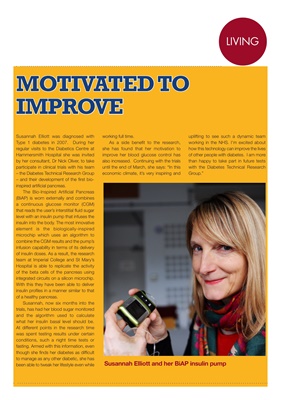
MOTIVATED TO
IMPROVE
LIVING
LIVING
Susannah Elliott was diagnosed with
Type 1 diabetes in 2007. During her
regular visits to the Diabetics Centre at
Hammersmith Hospital she was invited
by her consultant, Dr Nick Oliver, to take
participate in clinical trials with his team
- the Diabetes Technical Research Group
- and their development of the first bioinspired
artificial pancreas.
The Bio-Inspired Artificial Pancreas
(BiAP) is worn externally and combines
a continuous glucose monitor (CGM)
that reads the user's interstitial fluid sugar
level with an insulin pump that infuses the
insulin into the body. The most innovative
element is the biologically-inspired
microchip which uses an algorithm to
combine the CGM results and the pump's
infusion capability in terms of delivery
insulin doses. As a result, the research
team at Imperial College and St Mary's
Hospital is able to replicate the activity
of the beta cells of the pancreas using
integrated circuits on a silicon microchip.
With this they have been able to deliver
insulin profiles in a manner similar to that
of a healthy pancreas.
Susannah, now six months into the
trials, has had her blood sugar monitored
and the algorithm used to calculate
what her insulin basal level should be.
At different points in the research time
was spent testing results under certain
conditions, such a night time tests or
fasting. Armed with this information, even
though she finds her diabetes as difficult
to manage as any other diabetic, she has
been able to tweak her lifestyle even while
working full time.
As a side benefit to the research, she
has found that her motivation to improve
her blood glucose control has also
increased.
Susannah, who is continuing with the
trials until the end of March, comments:
"In this economic climate, it's very inspiring
Susannah Elliott and her BiAP insulin pump
and uplifting to see such a dynamic team
working in the NHS. I'm excited about
how this technology can improve the
lives of other people with. I am more than
happy to take part in future tests with the
Diabetes Technical Research Group."